Experimental study on fast electron generation during internal crash
Chaowei MAI(麦晁玮),Liqun HU(胡立群),Liqing XU(徐立清),Zhengping LUO(罗正平),Shiyao LIN(林士耀),Yiping CHEN(陈一平) and EAST Team
1 Institute of Plasma Physics,Hefei Institutes of Physical Science,Chinese Academy of Sciences,Hefei 230031,People’s Republic of China
2 University of Science and Technology of China,Hefei 230026,People’s Republic of China
Abstract Hard x-ray(HXR)burst is found during internal crash in the flat top current stage of experimental advanced superconducting tokamak(EAST)discharges and it is caused by fast electrons.The generated electrons during internal crashes may be an operational safety issue in advanced tokamaks.During an internal crash,locations of fast electron generation from HXR evolution agree with areas of magnetic reconnection from soft x-ray(SXR)tomographic reconstruction.Further statistical analyses show a 27 μs time difference between SXR crashes and HXR bursts,and the agreement between time broadening of HXR bursts and estimated characteristic time of magnetic reconnection in EAST.The magnetic reconnections during internal crash are proved to generate fast electrons,by both spatial and temporal agreements.
Keywords:EAST,internal crash,fast electron,magnetic reconnection
1.Introduction
Internal crash in tokamak is a soft disruption but not terminating the discharge,which causes sawtooth-like signals(e.g.the time trace of the x-ray emission)without inversion surface[1,2].During a typical sawtooth crash,signals are sawtoothlike inside an inversion surface and raise outsides the surface.It is found that the toroidal coupling of multiple magnetohydrodynamics(MHD)modes with different poloidal mode numbers(m),but with a single toroidal mode number(n),dominates the dynamics of internal crash[3].Plasma temperature is limited under internal crashes.Therefore,experimental study on internal crash is of great significance for improving the plasma confinement and controlling MHD[4].
Magnetic reconnection can accelerate electrons,which is found to generate fast electrons(several tens to several hundreds keV)in solar flares[5,6]or even runaway electrons(over several hundreds keV)in tokamaks[7,8].Similarly,suprathermal electrons(15-30 keV)during sawtooth crashes are found in the TCV tokamak[9].The relation of fast electron response and large sawtooth crashes has been investigated in the experimental advanced superconducting tokamak(EAST)[10].In this paper,we report fast electron generation during internal crashes in EAST,as a result of the magnetic reconnection.For advanced tokamaks,like the Chinese Fusion Engineering Testing Reactor(CFETR)[11]or the International Thermonuclear Experimental Reactor(ITER)[12],the accelerated electrons by internal crashes in plasma with higher energy density will be an operational safety issue because of potential damage to the first wall.
In the following sections,spatial comparisons among fast electron generation,fast electron and magnetic reconnection during an internal crash in a typical discharge of EAST are shown in section 2.In section 3,the average time difference proves a synchronism between soft x-ray(SXR)crash and hard x-ray(HXR)burst,and the HXR average bursting time length is compared with the estimated magnetic reconnection time in EAST.A short conclusion is given in section 4.
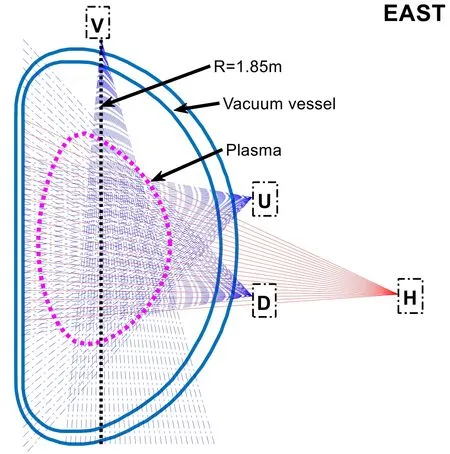
Figure 1.Sightlines and poloidal locations of SXR and HXR diagnostics in EAST.V is the vertical SXR detector.U and D are the up and down horizontal SXR detectors,respectively.H is the HXR detector.The plasma region is marked by the dotted edge.A R=1.85 m route is given by a vertical dot line.The lines of sight of SXR are dash dot lines from V,U and D,and the ones of HXR are solid lines from H.
2.Experiment setup
The results in this paper were obtained in EAST during the 2016-2020 campaigns.EAST is the first noncircular superconducting tokamak in the world.Its major radiusR=1.75−1.85 m,and its minor radiusa=0.45 m.The typical toroidal magnetic field operates in the range ofBT=1.8−2.6 T.EAST plasma has poloidal betaβp=0.3−0.5and electron temperature can be up to 8000 eV[8,13].
The mainly related diagnostic systems on EAST are the SXR and HXR measurements.Although the detectors of SXR and HXR do not all work in the same section,figure 1 shows the poloidal locations of detectors to EAST’s vessel.The poloidal SXR measurement system on EAST consists of three linear arrays.The arrays(U,D and V in figure 1)have their own beryllium filter foils with thickness of 12.5μm,and have 46,46,30 channels,respectively[13].SXR signals are lineintegrated data of plasma isotropic SXR emission,which is mainly from thermal electrons,on the chord of channels’sight lines(dash dot lines in figure 1).The HXR measurement system on EAST includes a linear poloidal array of 20 channels(H in figure 1).Each channel has aCdTe detector sensitive to fast electron emission(20-200 keV)that is directional[14].Both SXR and HXR have the same frequency of 100 kHz(time resolution at 10 μs).The spatial resolution of SXR is about 2-3 cm,and that of HXR is 3.5 cm.
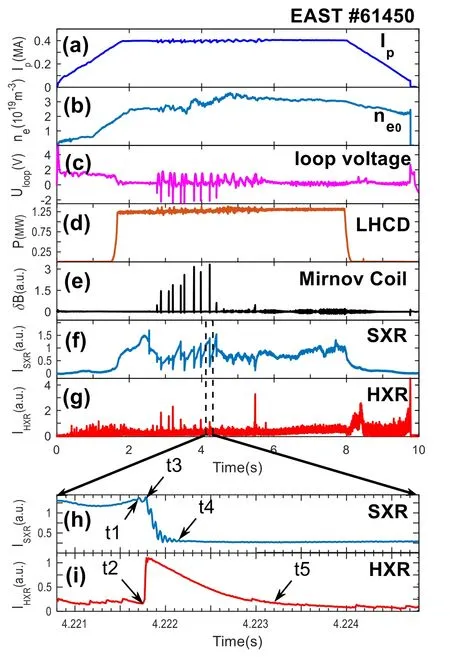
Figure 2.A typical discharge(#61450)in EAST.(a)Plasma current Ip ,(b)line-averaged density ne0 on the core chord,(c)the loop voltage,(d)the power of 4.6 GHz LHCD is 1.25 MW,(e)the raw Mirnov coil signal,(f)SXR on the core chord,and(g)HXR on the core chord.An internal crash is shown in(h),and HXR burst in(i)at the same time.Time t1,t2 are the start of internal crash and HXR burst,and t4,t5 are the end of them.Time t3 is the moment of the highest SXR point.
2.1.Observations
Internal crash in EAST can be identified based on SXR measurement.Researched data are complete discharges with internal crashes in the steady stage of plasma current,and plasma will return to non-crash before the decrease of plasma current.A huge sawtooth-like SXR crash can be found during an internal crash.
Plasma in EAST’s typical discharge #61450 shows internal crashes from 3 s to 6 s in the steady stage(figure 2(f)),and #61450 is a complete discharge.In the steady stage,plasma current is only driven by 1.25 MW lower hybrid current drive(LHCD)of 4.6 GHz(figure 2(d))according to the zero loop voltage level,and the perturbation of plasma current is found atΔIp/Ip≤4.3%(figure 2(a)).Few fast electrons are from LHCD and lead to the low HXR background(figure 2(g)).Every internal crash in #61450(figure 2(f))composes magnetic changes in the wide area of plasma,especially MHD with the same n.As a result,there are the magnetic disturbance(figure 2(e))and the variation of loop voltage(figure 2(c))for every crash.Several internal crashes accompany the corresponding HXR peaks(figure 2(g)).Here,the HXR peaks are the responses to fast electrons,considering the low background fast electrons.A detail shortcut of SXR and HXR(figures 2(h)and(j))shows that at the start of internal crash(t1 in figure 2(h))SXR begins unstable and crashes at later t3.Soon at t2 in figure 2(i),HXR starts a 100 μs burst.The decay of HXR is much slower than the burst and after the end of internal crash at t4,HXR decays until t5.
To study the fast electrons,energy spectrum is very useful.However,as the total peak exists in 3 ms,the life time of generated fast electrons is too short to obtain an available energy spectrum directly from HXR measurement for further research.It is worth pointing out that corresponding bursts are not found in run-away detectors,not only in#61450,but also in all the observed discharges with internal crashes.It means that the generated fast electron radiation has not reached the lowest threshold of 0.5 MeV for the run-away detectors[15,16].
As a conclusion of observations,HXR burst starts almost the same time as internal crash(not the SXR crash).Further study on the generated fast electrons will be carried out without the electron energy spectrum.
2.2.Dynamics of internal crash
There are differences between internal crash and sawtooth crash.For example,sawtooth crash has an inversion radius,where the inner region has an opposite heat flow direction to the outer region.The entire region affected by internal crash has one flow direction only[3].Sawtooth precursor is usuallym=1 dominant,andm/n=2 /2 orm/n=3 /3 dominant in some cases[17],with weaker harmonics[18].Precursors of internal crash are usuallym=2 dominant,typically coupling tom=1 later at internal crash[3].
The MHD on the tokamak Z direction is shown by evolution of SXR profiles in figure 3.Figure 3(a)indicates that the internal crash of #61450 mainly affects fromZ=0 toZ=±35 cm.m/n=2 /1 mode in the precursor is identified in figure 3(b).m=1 in the core is driven by growingm=2 in the outer plasma.The start of internal crash is the appearance ofm=1.The SXR affected area of figure 3(a)indicates the comprehensive coupling ofm=2 andm=1.
2.3.Locations of fast electron and its generation
The locations of fast electrons and their generation during internal crash can be observed by HXR profiles(figure 4),after the directional HXR emission of fast electrons considered[19].It is clear in figure 4 that after the internal crash starts at L1,almost all HXR channels burst at the same time L2,and fast electrons exist after SXR crash end at L3.The HXR decrease here may be caused by a decreasing population of fast electrons or the decay of fast electron energy,e.g.synchrotron radiation energy loss,radial diffusion and slowing down[9,20].Figure 5 shows the evolution of HXR perturbation profiles for the locations of fast electron generation.Five hot spots(p1-p5 in in figure 5)indicate that the generation of fast electrons should be a compressive process with the multiple mode number m.
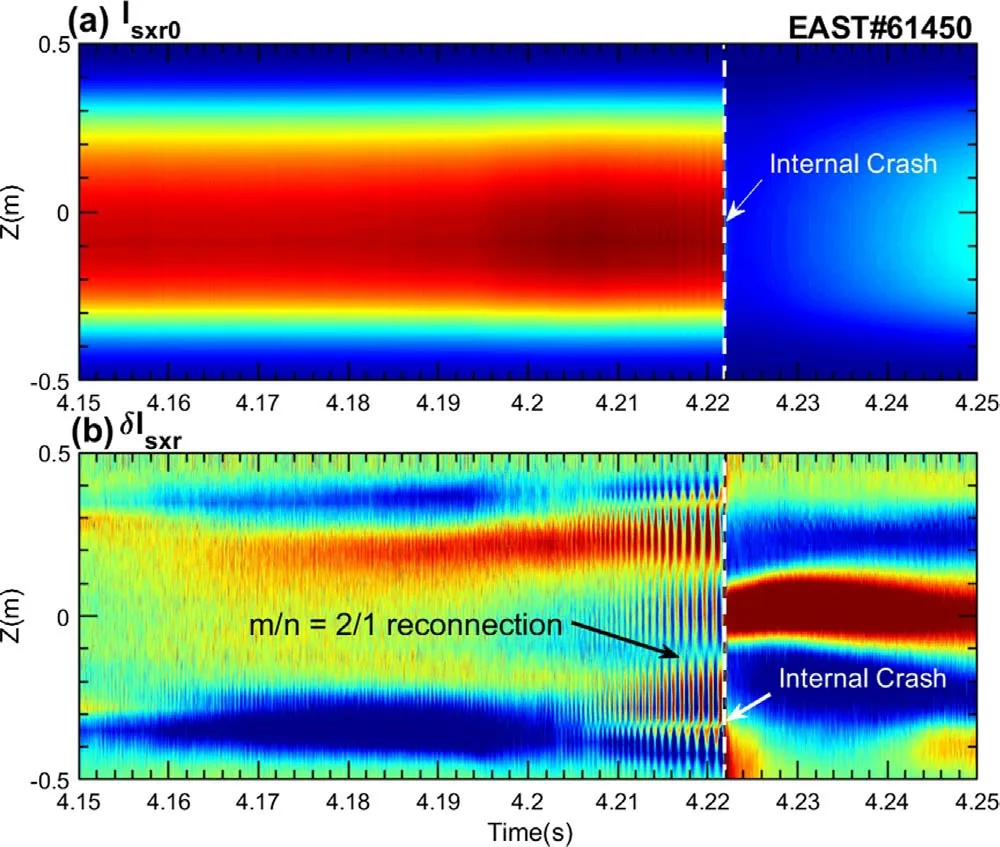
Figure 3.Evolution of SXR profiles at an internal crash in EAST’s typical discharge #61450.(a)Evolution of equilibrium SXR profiles.(b)The perturbation SXR profiles.Ordinate is Z of the poloidal surface location(R=1.85 m,Z).Internal crash moment is marked by dash vertical lines.m /n=2 /1 mode pointed in(b)appears 20 ms before internal crash and disappears after that.
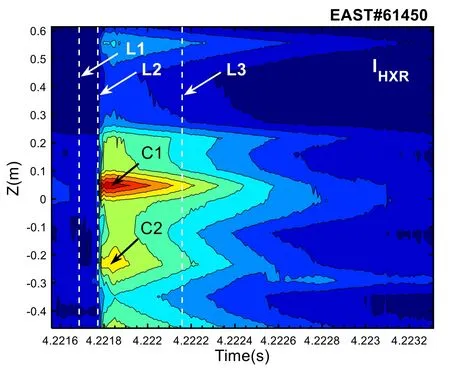
Figure 4.Evolution of raw HXR profiles on HXR peak at 4.22 s in EAST #61450.Ordinate is Z of the poloidal surface location(R=1.85 m,Z).L1 is the start of the SXR crash.L2 is the start of HXR burst in most channels.L3 is the end of SXR crash.C1 and C2 are the locations of channels with hot HXR during HXR decay.
In order to discuss the evolution of HXR and its perturbation,MHD mode spatial structures are observed by SXR tomographic reconstruction[21].Poloidal isoemissivity surface from SXR tomographic reconstruction is generally considered to be the magnetic surface or isobaric surface.Based on the tomography of 3 SXR arrays on EAST,the MHD structure ofm≥3 is unreliable[21].However,it is a good tool for the MHD mode spatial structure withm=2 orm=1(figure 6).
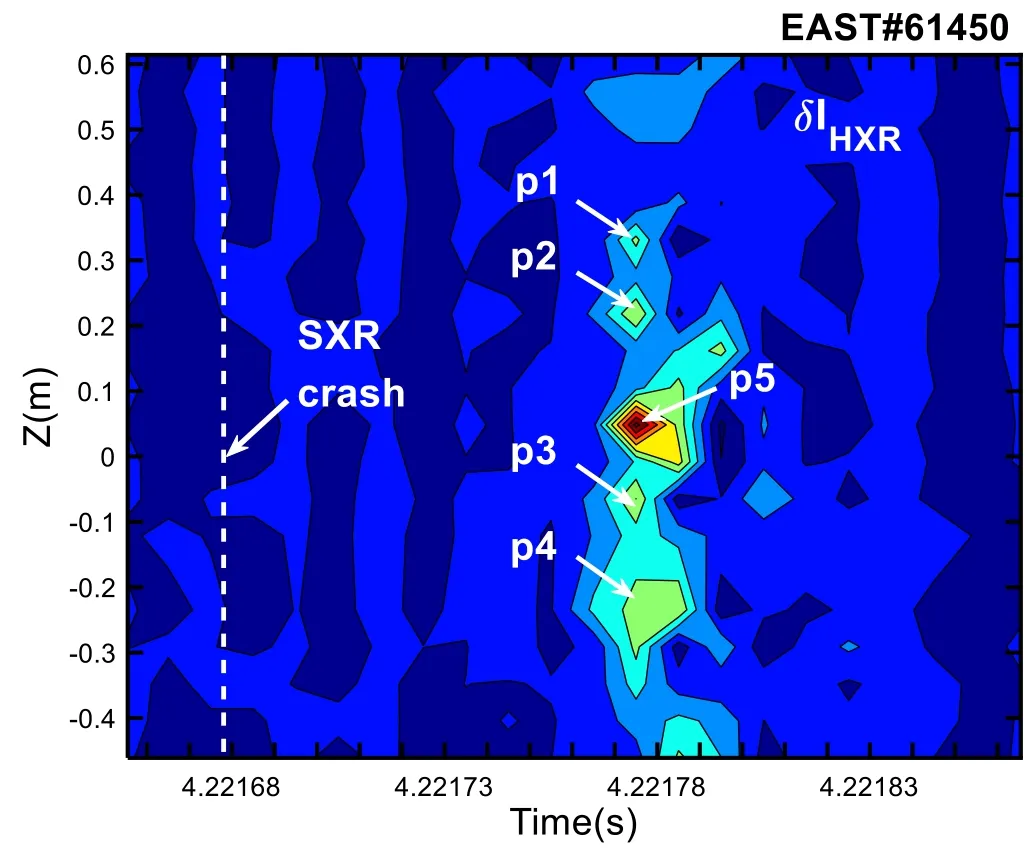
Figure 5.Evolution of HXR perturbation profiles on HXR burst at 4.2218 s in EAST #61450.Ordinate is Z of the poloidal surface location(R=1.85 m,Z).SXR crash moment starts at the vertical dash line.The p1-p5 are hot points with higher growth rate of HXR.
In the MHD-free phase at 4.18 s(t1 in figure 6(a)),there are no MHD mode and no magnetic reconnection.The hollow distribution of SXR profiles in figure 6(b)is a result of plasma impurities[22].The impurities lead to strong radiation loss in the core and then cause the precursor MHD mode ofm=2.
In the precursor phase of internal crash in figure 6(a),the frequency of Mirnov signal shows the evolution ofn=1 plasma rotation.m=2 magnetic islands and reconnection are observed in figure 6(c)at 4.2210 s(t2 in figure 6(a)).With the increase of precursorm/n=2 /1,m=1 appears and SXR crashes at 4.2218 s(t3 in figure 6(a)).In figure 6(d),there ism=1 butm=2 structure is not observed because it is squeezed to the q=2 surface(Q in figure 6(d))bym=1[3].
At t3,there are five fast electron generations at hot points p1-p5 in figure 4 and they can be divided into two cases.The first case is the fast electron generation at p1-p4.After generation,they have HXR response at C2 in figure 4.The locations of the first case agree with the q=2 surface wherem=2 reconnection takes place(Q in figure 6(d)).In the other case,fast electrons generated at p5 the same as r1(R=1.85 m,Z=0.05 m)in figure 6(d)and had HXR response at C1 in figure 4.The reconnection area ofm=1 is clearly at r1 in figure 6(d).Additionally,the HXR response channels C1 and C2 in figure 4 show the generated fast electrons keep in r1 and Q in figure 6(d).Slowing down may play an important role in the decay of fast electrons[9,19,20].Because fast electron energy remains unknown,the decay time of slowing down and radial diffusion coefficient are unavailable to be estimated and compared with the actual decay time.Due to the limited amount of HXR channels,there is a gap(R=1.85 m,ΔZ=5.66 cm)between every sight lines of channels.It is difficult to locate and outline fast electron or its generation more exactly,especially the radial diffusion of fast electron and the directions of electron acceleration.
After an internal crash at 4.2240 s(t4 in figure 6(a)),MHD modes and generated fast electrons are extinct,and there is no magnetic reconnection(figure 6(e)).Impurities that cause strong radiation loss are expelled from core plasma,according to the peaked SXR profile in figure 6(e).
In summary,the locations of fast electron and its generation agree with the areas of magnetic reconnection according to SXR tomographic reconstruction surface.Magnetic reconnection during an internal crash of #61450 accelerates electrons,including reconnection areas of outerm=2 and the one ofm=1 in the core.
3.Statistical analyses
Data used in section 3 are time points with HXR peak during internal crash in the discharges similar to#61450.In details,the discharges of data are complete discharges with steady high-power LHCD,zero loop voltage and low HXR background.That means the plasma current is driven mainly by LHCD and there are no large numbers of background fast electrons from LHCD.No neutral beam is injected at the time points or else HXR is affected[14].
Statistical analyses are performed between fast electron generation,internal crash time and its magnetic reconnection.In order to study the time relation of fast electron generation and internal crash,time differences between them are counted in section 3.1.The time broadening of fast electron generation is compared with magnetic reconnection time in EAST in section 3.2.
3.1.Time distance between fast electron generation and internal crash
This paper defines the half variation point of SXR crash or HXR jump,as the moment that variation firstly comes to half of the maximum variation.Average time difference between SXR crash and HXR jump counts the differences between half variation points of SXR crash and HXR jump.The time distance between SXR crash and HXR burst is studied using this time difference.
Statistics of section 3.1 are based on 82 sets of half variation points from 25 EAST’s discharges.The average time difference is 27 μs,meaning that HXR burst happens 27 μs earlier than SXR crash using half variation points.Both SXR and HXR have the same time resolution at 10 μs.Time difference between half variation points should have a range ofSystem error between SXR channels is 1.3 μs,and the one between different HXR channels is 0.4 μs.Also,between different SXR arrays,which are on the same poloidal section with different angles to plasma,system error is 2.2 μs.Total system error from measurement is 2.9 μs.In all,average time difference is26 ±8μs,as the time resolution and measurement system are independent factors for errors.In EAST,the time broadening of SXR crashes is about 80−200 μs with the uncertain end points of SXR crash,and one of HXR is roughly 20−100 μs.HXR bursts and SXR crashes are at the same time in EAST,within their time broadening.
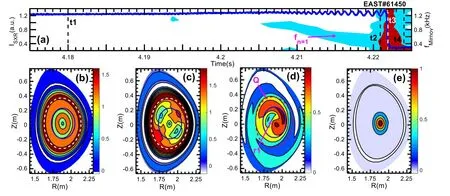
Figure 6.SXR tomographic reconstruction on the crash at 4.22 s in EAST#61450.(a)A core SXR and a Mirnov coil frequency spectrum.Time points t1-t4 in(a)are the moments of(b),(c),(d)and(e).The evolution of frequency of n=1 is marked.Position r1 marks m=1 reconnection area.The solid circles indicate the q=1 surface,and dashed circles(including Q in(d))show the q=2 surface.
It is worth pointing out that positive average time difference does not conflict with the discussion in section 2.3.SXR begins unstable because ofm=1 appearance in an internal crash and drops sharply after a period,for example,the t1 crash is 100 μs earlier than the start point t3 in figure 2(h).After this period considered,HXR bursts begin later than internal crashes do.
3.2.Time broadening of fast electron generation
Though the background HXR disturbs the identification of HXR burst starting points,the time broadening of fast electron generation can be studied by HXR bursting time lengths.Results are from 82 sets of data mentioned in section 3.1.Over 95%HXR bursting time lengths are between 20 μs and 100 μs,and average HXR bursting time length is 60 μs.There is a range of±5μs at both ends of the time length based on HXR time resolution(10 μs).As start-time points and endtime points are selected separately,average HXR bursting time length should have a range ofThe system error from HXR channels is 5.7 μs.In all,average HXR bursting time length is
In section 2.3,the locations of fast electron generation during internal crash are found to agree with areas of magnetic reconnection in discharge #61450.In this section,the time broadening of fast electron generation should be compared with estimation of magnetic reconnection time.As magnetic reconnection can be described by many models,the conditions of models,characteristic reconnection time scale and their estimations are summarized in table 1.Column 1 in table 1 are spatial conditions in the form ofW/δ,the ratio of width of magnetic reconnection to layer width.Column 2 in table 1 are conditions that constant magnetic flux function(Ψ)is valid or not.Magnetic flux is constant when variation of magnetic energy is perturbation,and one is non-constantagainst the condition.Column 3 in table 1 are characteristic time scale formulas given by different models.Column 4 in table 1 are the estimates of characteristic time scale in EAST based on the formulas of column 3.
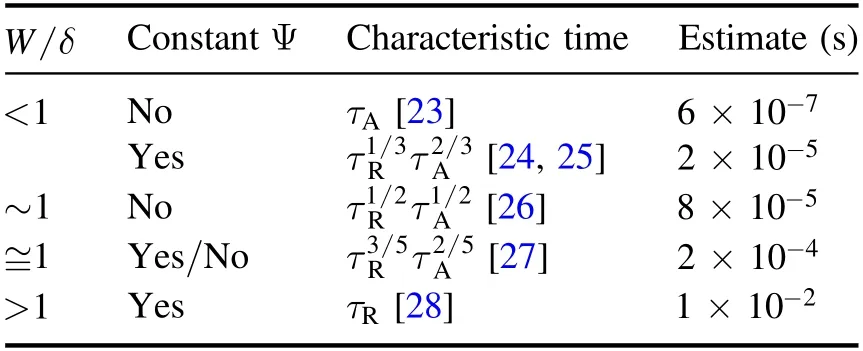
Table 1.Summary of estimates of magnetic reconnection characteristic time scale in EAST by different evolution models.
Here,resistance diffusion time is[27],where a is EAST’s minor radius andη⊥is radial electron resistivity[29].Alfvén wave time isτA=R/vA,where R is EAST’s major radius in section 2,andvAis Alfvén wave speed.The Alfvén speedvAis calculated using[2],whereφBis the magnetic field intensity on the magnetic surface,μ0is the permeability of vacuum,niis the ion density,mi=Zeffmpis the ion mass,Zeffis the effective on charge andmpis the proton stable mass.The resistivity is estimated by[30],whereBTis the tokamak toroidal magnetic field,Ipis the plasma current,τdis the characteristic time for change of the plasma density[30]andβpis the poloidal beta of plasma.
In EAST,it is constant thata=0.45 m,andR=1.8 m.It is estimated thatBφ≈BT≈2 T,Zeffni=ne≈ 2×1019m−3,Zeff≈3,βp≈0.4andτd≈2 s for most of thevA≈ 3 ×106m ·s−1,η⊥≈2.1 ×10−5Ω·m,τA≈5.5×plasma flat top current stage[30].It is calculated that 10−7sandτR≈1.3 ×10−2s.
From the estimate of magnetic reconnection time at 80 μs in table 1 and average HXR bursting time at 60 μs,time broadening of fast electron generation agrees with the magnetic reconnection time based on Kadomtsev reconnection model[26].In other words,fast electron generation and magnetic reconnection have a similar time length.
4.Conclusions
HXR is found to burst during internal crashes in EAST.Because of short lifetime of generated fast electrons,the HXR electron energy spectrum during internal crashes is unavailable for a direct evidence.Section 2 gives an agreement between locations of fast electron generation and areas of magnetic reconnection in two cases.The agreement indicates that magnetic reconnection ofm=1 andm=2 during internal crashes accelerates electrons to fast electrons.From section 3,on one hand,more discharges are considered and there is an average time difference between HXR burst and SXR crash at 27 ±8μs.There is fast electron generation during internal crashes in those discharges.On the other hand,the time broadening of fast electron generation at 60 μs agrees with the estimated magnetic reconnection characteristic time at 80 μs in EAST.This means that fast electron generation have a similar time length of magnetic reconnection.In summary,there are fast electrons generated during internal crashes in EAST and the generation is proved to be a result of magnetic reconnection by both spatial and temporal agreements.
 Plasma Science and Technology2021年4期
Plasma Science and Technology2021年4期
- Plasma Science and Technology的其它文章
- Photon and positron production by ultrahigh-intensity laser interaction with various plasma foils
- Nonlinear phase dynamics of ideal kink mode in the presence of shear flow
- Dynamical evolution of cross phase of edge fluctuations and transport bifurcation
- Stability analysis of Alfvén eigenmodes in China Fusion Engineering Test Reactor fully non-inductive and hybrid mode scenarios
- Measurement of time-varying electron density of the plasma generated from a small-size cylindrical RDX explosion by Rayleigh microwave scattering
- Modelling of electronegative collisional warm plasma for plasma-surface interaction process
